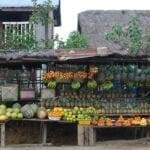Southern Madagascar is called the arid south and is noted for its many remarkable species of cactus and baobab-like plants; however; it also has some great beaches to visit.
Southern Highlands of Madagascar
Fianarantsoa, a provincial capital; shortened to Fianar by the locals; is an important center for wine and rice production and a good base for exploring the southern highlands of Madagascar. It is about 400 km’s from Antananarivo and offers visitors a mix of wavy valleys, vineyards, and tea plantations.
From here attractions include:
- Ranomafana National Park is one of Madagascar’s most popular parks with ancient rainforests, flora, and fauna. There are 12 species of lemurs here including the critically endangered golden bamboo lemur. Night walks highlight the diversity of exotic frogs, reptiles, and insects.
- Visit Amabalavao to buy silk and Antemoro paper; which is a flower-embedded papyrus-type paper.
- Ambositra and the neighboring Zafimaniry villages, where intricate wood carving and architecture are prominent.
Isalo National Park
Isalo National Park is approximately 690.6 km southwest of Antananarivo; en route to Toliara. One of Madagascar’s most beautiful parks with a chain of sandstone cliffs that can be seen from miles away. At different times of the day due to iron and mineral deposits that stain the rock formations; it is a photographer’s dream. It is the Arizona of Madagascar; with the rock formations, reddish hues, and desert landscapes; said to resemble the Wild West of an old-school cowboy movie. Another fascinating attraction is the Window of the Isalo, which is especially beautiful at sunset.
Its interior boasts canyons filled with waterfalls and valleys; dominated by endemic trees and feather palms. Elephant’s Foot and Isalo Aloe dot the cliffs and rocks. While the spectacular mountains of Isalo are the park’s most famous feature; there are other attractions worth seeing; such as natural swimming pools, and the astounding scenery at the Canyon des Singes and Canyon des Rats. The narrow Canyon des Singes (which means “canyon of monkeys”) offers a long, hot walk through the hidden canyons to a natural swimming pool; where a stone cave overlooks a crystal-clear waterfall; flowing into an emerald pool surrounded by leafy trees.
Although animal life is not the park’s most prominent feature; there are a few species to look out for; including Catta lemur, Ring-tailed lemur, Red-fronted brown lemur, Blackhead lemur, and also the Verreaux sifaka; a white lemur with a black snout and brown cap. There are 55 species of birds and many chameleons plus the beautifully colored Malagasy rainbow and the Isalo Madagascar frogs.
The East Coast
Taolanaro (formerly Fort Dauphin), in the southeast corner of the island; has a backdrop of green mountains flowing into the blue sea. Climb to the top (529 meters) to see this magnificent view of the city. Also; the Lokaro Islands, Evatra Point, Andriambe Lagoon, Anosy Mountains, Dauphine Cove, Libanona Beaches, Portuguese Islet; are all visible from the top of the peak.
The city and surrounding area are famous for seafood, orchids, and as a matter of fact; carnivorous pitcher plants at Berenty’s Reserve! Fort Dauphin has many historical sites and is also the lobster capital of Madagascar.
The Southwest
Toliara; a provincial capital on the southwest coast; has excellent bathing beaches and opportunities for skin-diving, fishing, sailing, and other water sports. The weather is warm all year round and sometimes there is no rain at all.








